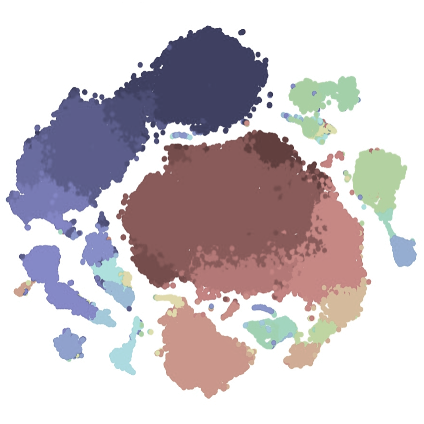Here we provide some guidelines for getting started with Imaging Mass Cytometry.
Overview of IMC
Imaging mass cytometry (IMC) using the ‘Hyperion’ system from Fluidigm allows for very high-dimensional analysis of tissue sections, by combining laser-ablation and mass cytometry. Slides are labelled with metal-conjugated antibodies against a variety of targets, and an ablation laser vaporises spots on the tissue section, 1 um at a time. The plume of material vaporised spot is drawn into the CyTOF, where the relative abundance of each distinct metal tag is measured. As the desired region is progressively ablated, an image comprised of the metal abundance is stitched together, resulting in >30 parameter ‘images’. The Hyperion acquires data at approximately 0.75 mm^2 per hour.
Tissue preparation
One of the primary causes of reduced staining is oxidation of epitopes on exposed slides. Whilst epitopes are encompassed within the tissue, they are not exposed to oxygen and are unlikely to degrade. Once a slide has been cut, oxidisation will start to occur. Whilst appropriate storage (the colder the storage, the slower the degradation) and/or fixation as soon as possible after cutting will help, it is best practice to cut as close to the time of staining as possible. Typically we recommend that slides be fixed within one hour after cutting, and then used immediately, or stored at -80*C until staining.
Formalin-fixed paraffin-embedded
Imaging mass cytometry can be applied to both frozen sections, as well as formalin-fixed paraffin embedded (FFPE) sections. Because many cellular epitopes are modified during the formalin fixation process, most antibodies used for conventional suspension mass cytometry will not adequately label. As such, separate FFPE validated antibodies must be conjugated to metal tags and tested for FFPE sections. As such, antibody clones that are compatible with epitopes in fixed samples are often different to the clones that would typically be used for unfixed samples. Frozen sections do not change the target epitopes as dramatically as FFPE does, and so many of the conventional antibodies work on frozen sections. Because of this, we have active operational panels for frozen mouse tissues, but are still developing panels for mouse FFPE sections (due to the extended time required to purchase and validate FFPE antibodies).
Frozen tissues
Samples that are frozen in O.C.T. are often frozen fresh (i.e. they are not fixed before being frozen), to preserve protein epitopes. The trade-off here, is reduced quality of cellular morphology. In order to use the standard CyTOF antibodies (that are normally used for suspension mass cytometry) for IMC it is better to use fresh-frozen sections, as many of the antibodies will still bind. When using fixed-frozen samples, selecting antibody clones that are compatible is critical. After sectioning, some fixation is usually performed to prevent the degradation of protein epitopes, and to help the section adhere firmly to the slide. The most common options are listed in the protocol below, these are usually performed for no longer than 10 min, so as to have a minimal impact on epitope degradation.
Sometimes tissues are pre-fixed prior to freezing in O.C.T. The most common approaches here are either to perfuse the circulatory system with fixative (animal samples only), usually PFA or formalin. Alternatively, samples may be extracted ‘fresh’ and then placed in PFA or formalin for a period of time for fixation. A combination of both perfusion and submersion fixation may be used. After sectioning, some kind of post-fixation (post-fixation referring to fixation after sectioning and mounting on a slide) is sometimes performed, although whether to post-fix or not is up to the discretion of the individual. For pre-fixed frozen tissues, with recommend performing the acetone or methanol fixation steps described in the protocol below.
General staining tips
Lack of amplification
Amplification is not typically used in staining protocols for IMC. If an amplification kit is included, then sections need to incubated in 0.3% H2O2 in PBS for 10 min (up to 3% for up to 30 min, depending on the tissue) prior to staining. This can be performed prior to the Avidin/Biotin block.
Slide arrangements
The Hyperion operates automatically when ablating tissue sections from a single slide, and requires user interaction whenever a slide is changed. As such it is advantageous, where possible, to put as many desired sections on the same slide as possible.
